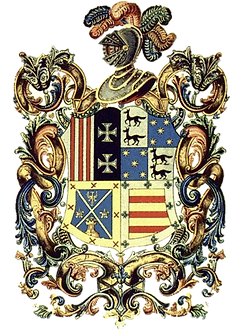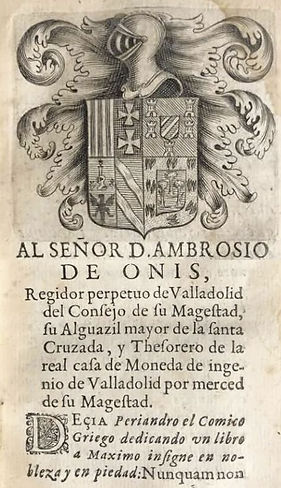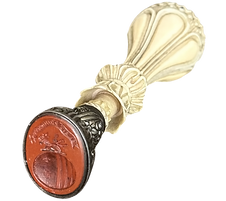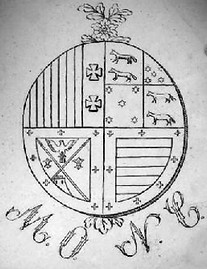The Onis Family
A family from Salamanca with several centuries of history



The Origins of the Onís Family.

The Onís family traces its roots to Asturias, specifically to the town of Onís, also known historically as Bedia. Until well into the 20th century, this was the site of the Tower of Villoria de los Onís, a symbol of the family’s ancestral home and noble status. From this Asturian origin, the Onís family spread to Galicia, particularly to Pontevedra, where around the late 16th century Juan de Onís settled and served as regidor of Pontevedra. From him came two main branches of the lineage: one established in Valladolid, the other in Cantalapiedra (Salamanca), both emerging in the early 17th century.
In the Valladolid branch, notable figures included Ventura, son of Juan, who lived in Valladolid, and his son Ambrosio, who in 1680 was elevated to the title of Count, then Marquis, of Olivares del Duero. The Marquess of Olivares is a title of nobility that was created in 1680 by King Charles II in favor of Ambrosio de Onís, who was Minister of the Council of Finance, and perpetual alderman of Valladolid. Its name refers to the town of Olivares de Duero, over which right of vassalage had been acquired in 1647 by Ventura de Onís. His descendants were still living in Madrid in 1971, holding other titles such as Count of Polentinos and Count of Cancelada.
The Valladolid branch. Ambrosio, Count of Olivares del Duero.
The Cantalapiedra branch of the Onis family is believed to descend from a son of Juan’s fourth wife, probably Licenciado Andrés de Onís, who may have been a physician or jurist. He lived as a rural hidalgo farmer but sent his sons to study at the University of Salamanca. By the mid-18th century, three brothers from this branch, José, Raimundo, and Joaquín de Onís López y González, were trained in the humanities and law in Salamanca, entering the diplomatic service under King Charles III, a ruler celebrated for his enlightened reforms. In 1783, these brothers received their Letter of Nobility or Certification of Arms from the Royal Chancery of Valladolid, supported by documentation from the family’s ancestral tower and from Count Ambrosio’s records. Some of these letters survive in municipal and university archives, and one was even held at the University of Puerto Rico, donated by Federico de Onís, a distinguished scholar of the family. The family’s Cantalapiedra home reflected this status: not a palace, but a substantial ancestral house with a coat of arms on the façade, and a family archive kept in Salamanca by descendants such as Don Carlos de Onís.

The Cantalapiedra line.
Document with the arms of Ambrosio de Onis
The Onis coat of arms.
José de Onís y López González y Gómez (1726-1802)

In 1783, Don Joseph de Onís López González y Gómez and his legitimate descendants were formally granted the right to use the family coat of arms. This privilege allowed them to have the arms engraved, carved, or painted on seals, rings, banners, stonework, houses, gateways, tombs, and other customary places, without any obstacle or prohibition, public or private. The certification was issued in Madrid on 27 May 1783 by Don Ramón Zazo y Ortegoa, Chronicler and King of Arms in all the Kingdoms, Domains, and Lordships of King Charles III of Spain. The document states that the hidalgos (noblemen) of this surname use several variations of arms, but the one described in this certification consists of: Field of gold, with three red fesses, Silver border charged with eight green crosses of the type used by the Order of Calatrava (as shown in the last quarter of the General Arms), Additional elements in the complete family arms include wolves, stars, saltires (X-shaped crosses), an eagle, and a castle.
The prominent members of the Onis family.
One of the family’s first notable diplomats was José de Onís López y González, appointed Spanish ambassador to Catherine II of Russia in 1790. He married his niece, María Manuela de Onís González-Vara, and travelled with her to Russia, keeping a detailed journal titled Diary of the Journey from Cantalapiedra to St. Petersburg in 1792. His service ended in 1796, and although he died childless in 1816, he left a considerable fortune. His younger brother Joaquín lived between Cantalapiedra and Salamanca. Married to Narcisa González Vara, he was a Knight of the Order of Charles III and served as mayor for the Noble Estate in his home town.
The family legacy.

Luis de Onís’s son, Mauricio Carlos de Onís y Mercklein, was born in Dresden in 1790 and died in Madrid in 1861. Raised in the diplomatic tradition, he served in postings in London and Berlin, and took part in peace negotiations with France after the Napoleonic Wars. From 1816, he was secretary of state, and in 1833 he joined the Progressive Party. He became senator for Salamanca, later life senator, and in 1839 served as Minister of State. In 1843, as President of the Senate, he administered the constitutional oath to the young Queen Isabella II.
The most famous member of the family is undoubtedly Luis de Onís y González-Vara, born in Cantalapiedra on 4 June 1762 and dying in Madrid on 17 May 1827. After graduating in law from the University of Salamanca, he entered the diplomatic service, initially as secretary at the Spanish legation in Dresden under his uncle, the ambassador to Saxony. He later gained prominence when he successfully requested Saxon mining experts for Spain, a project praised by the Count of Floridablanca, and was involved in the negotiations for the Treaty of Amiens (1802). In 1809, he was sent as minister plenipotentiary to the United States, though without immediate official recognition from the American government. After years of tense negotiations, he signed the famous Adams–Onís Treaty with John Quincy Adams in 1819. This treaty ceded Florida to the United States, established a clear U.S.–Spanish border in North America, and ensured Spain retained temporary control over Texas, New Mexico, and California. In 1818, he became Perpetual Alderman of Salamanca; in 1819, he was awarded the Grand Cross of the American Order and other honours. He was later appointed ambassador to St. Petersburg (a post he did not take up) and Naples, and in 1821 was sent to London to handle Spain’s response to the independence of its former American colonies. He returned to Madrid in 1822 and died in 1827.
Luis de Onís y González-Vara (1762-1827)
Mauricio Carlos de Onís (1790-1861)
Mauricio’s eldest son with Carolina Onís was Federico de Onís y Onís (1817–1886). A law graduate, he settled in Cantalapiedra and managed the estate called La Carolina (once the depopulated site of Mollorido). He developed a commercial nursery specialising in ornamental gardens and arboriculture, supplying cities such as Salamanca, Valladolid, Palencia, and Ciudad Rodrigo. A famous sequoia, planted under his direction, was presented to the University of Salamanca and still stands in its cloister. His son, José María de Onís, later served as librarian at the university.
The Onís family is a remarkable example of a noble lineage that, beginning with a regional base in Asturias, expanded across Spain and produced figures of national and international importance in diplomacy, politics, scholarship, and culture. The legacy of Luis de Onís, particularly through the Adams–Onís Treaty, left a lasting mark on the history of U.S.–Spanish relations and the territorial map of North America. His son Mauricio consolidated the family’s political stature in 19th-century Spain, while Federico added a cultural and philanthropic dimension to the family’s heritage through his agricultural work and contributions to the University of Salamanca. The heraldic shield on the Cantalapiedra house, the preserved letters of nobility, and the extensive family archives all serve as tangible reminders of the Onís family’s centuries-long presence in Spanish history, a blend of noble identity, public service, and intellectual contribution that continues to be recognized today. While the Onís family may not be a powerhouse in contemporary Spanish society or politics, they retain cultural and genealogical significance, especially in academia and regional heritage. Their noble title survives in name and tradition, even if it no longer confers legal or social power.





Gerry's Collection of Antique Seal Stamps.

